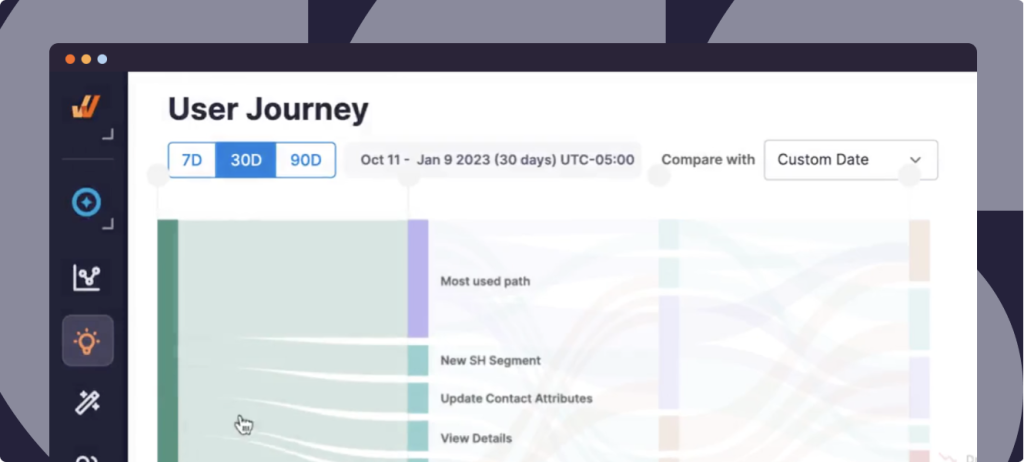Every technology and digital service company has product managers who align product strategy to business outcomes and drive product development, growth, and iteration. But what exactly is product management, and how does it drive product development?
In this guide, we’ll examine product management as a function, its history, and the various roles that can exist on a product management team in depth. We’ll also break down the critical responsibilities of product management and the software tool that empowers product managers to own the product management process.
What Is Product Management?
Product management guides a product’s entire lifecycle, which includes everything from positioning and pricing to development and design. A product management team is relentlessly focused on understanding customer needs and market conditions to create and implement a product roadmap that leads to a high-performing product with frictionless experiences that provide customer value.
Ultimately, product management is where business goals and customer value intersect, ensuring that both move forward in tandem to everyone’s benefit.
Product thought leader Martin Eriksson wrote a well-known and oft-quoted piece describing product management as the ‘intersection of business, UX, and technology.’ This is a valuable product management framework for understanding the scope of product management, so here’s what it means in a bit more detail:
- Business: Product management facilitates effective collaboration between development, design, the user base, and business leadership to ensure that everyone is working toward the same business goals and that the company is well-positioned to achieve them. Misalignment often makes it difficult for a company to hit its key KPIs without effective product management.
- UX: A crucial product management feature is a relentless focus on customers and their needs. Product managers ensure that all product-oriented initiatives give value to the customer and provide a quality user experience.
- Technology: Although product management responsibilities include people-oriented tasks like research and communication, product managers also utilize their technological understanding to help ideate and implement solutions to users’ needs that facilitate business goals.
The History of Product Management
Although there isn’t a specific date on which product management was founded, it is widely considered to be nearing its 100th birthday. In the 1930s, Neil H. McElroy, a marketing manager at Proctor & Gamble, popularized the idea of a “brand man” with a laser focus on a specific product rather than a typical business role.
Since then, product management has undergone fascinating and rapid development, leading to what is considered today one of the most critical roles at any company.
Here are the most significant milestones in the history of product development:
- Late 1930s: McElroy, by chance, taught Bill Hewlett and David Packard at Stanford University and his teachings were incredibly influential.
- Early 1940s – Early 1990s: Hewlett Packard was a rapidly growing company that was a role model to other business leaders, who noted and implemented the “brand man” philosophy, giving rise to what we now call product management.
- Late 1940s—Early 1950s: Toyota emerged as a significant company in the development of product management when it created newly aligned manufacturing principles and the kanban method of development. Many companies took note and followed suit.
- 1970s: The product management processes developed by manufacturing industries were often heavy and prolonged. In the ‘70s, efficiency became paramount, and the tech industry innovated on the product management ideas from earlier in the century by making them lighter and faster.
- 1980s: This was the decade where agile product development processes, conceptualized as ‘brand management’, took hold, with the tech industry leading the way. Product management was fast-paced and ubiquitous.
- 2001: The Agile Manifesto was written and widely distributed. The manifesto built on the learnings of the past several decades and created a specific framework for product management and product managers, leading more or less to the function and the role that we are familiar with today.
It’s been a long road to the agile manifesto, but it’s clear that product management is here to stay as one of the most in-demand talents in the technology industry. The field has become incredibly nuanced, with many different tasks and roles.
Product Management Roles
In this section, we’ll examine the various roles of a product management team today. Note that most product teams do not have all these roles but a combination that suits their specific organizational needs.
- Product Manager (PM): This is the flagship product management role, and a PM is expected to have absolute competency in business, UX, or design and fluency in the rest. PMs utilize these core competencies to drive the creation and implementation of the product roadmap, serving as the connector and communicator for all stakeholders involved.
- Technical Product Managers: A technical PM, like a PM, drives the product roadmap but is singularly focused on its technological aspects. This means they’re diving into and pushing forward the technical details needed for product iterations.
- Agile Product Managers: While Agile PMs are very much product minded, they’re generally more embedded in tech teams with their central function to move them through development cycles according to the product roadmap.
- Product Owner (PO): POs are similar to PMs in translating user needs and market realities into product initiatives. However, they are often more involved in managing the development backlog and translating vague product management strategies into actual technical tasks.
- Product Analyst: The analyst on a product team generally owns the entire user behavior data stack. They monitor and analyze user behavior and product usage, test iterations to improve on these benchmarks, and provide ways for others to view product analytics and related metrics in self-service dashboards.
- Product Marketing Manager (PMM): PMMs work at the intersection of product, marketing, development, and sales to create and implement a marketing strategy aligned with cross-functional goals.
- UX Research (UXR): UXRs use both quantitative and qualitative research methodologies to help product managers, designers, marketers, and others understand the needs, motivations, and behaviors of the user base and target audience in general.
- Chief Product Officer (CPO): The CPO owns the entire product function at a company and is generally the final decision maker regarding overall product strategy.
- Product Service Managers: Product service management works on products from a service-side perspective, like new add-on services. PSMs often carry similar responsibilities to a traditional PM, simply from a service side.
Essential Product Management Skills
At this point, it’s important to note that not all product managers will have all of the skills below. Different organizations have differing expectations depending on the nature of the product and company culture. However, some combination of the skill sets below is almost always required.
- Communication: Excellent written and verbal communication skills are essential for PMs to create motivation and alignment on the product team and beyond.
- Collaboration: Since product teams work in tandem with development, marketing, and other teams, PMS must be masters of cross-functional collaboration.
- UX: User Experience is where the product strategy meets the user, and PMs are often expected to have intimate knowledge, if not direct experience, about UX best practices.
- Strategic business understanding: Ultimately, the product serves the business. For that reason, PMs need to understand how to create and implement product iterations that serve the company’s overall business strategy,
- Project management: While developing a roadmap is a crucial part of the PM role, PMs are also expected to ensure that the various pieces of each product initiative happen when and how they are supposed to.
- Technical skills: Particularly on teams with highly technical products, PMs are often expected to have coding knowledge and know-how.
- Data-driven: PMs must ensure all product initiatives align with user behavior metrics. Generally, the role involves tracking these metrics, analyzing the data, and conducting A/B testing to improve user experience and product iterations to test new features.
- Storytelling: PMs must understand the product’s value proposition and the reasoning behind all product initiatives regarding user needs and company strategy. They also need to be able to tell the story behind it to foster cross-functional motivation and alignment.
Product Management Responsibilities
Product management responsibilities fall into six core areas: market research and understanding problems, customer engagement and feedback, defining product strategy and vision, product roadmap and feature prioritization, delivering value and analyzing user behavior, and enabling product operations.
Let’s break down each area below:
1. Market research and understanding of core problems
PMs and other product pros will either be involved in or execute various activities that help the entire organization understand the target audience in the most nuanced way possible.
They’ll need to ascertain precise market conditions and the precise problems that their products will need to solve, which is done via primary and secondary market research, segmenting the market, and evaluating key events and trends impacting it.
Utilizing this methodology will enable product teams to be on top of key user needs and challenges, and the market within which a company needs to sell solutions. It should be noted that market research and user understanding is an ongoing responsibility, as markets and user needs will evolve.
2. Customer engagement and feedback
Successful product management entails engaging with customers. One way to do this is by soliciting and reacting to customer feedback. This is often referred to as having a customer-centric mindset, which is a constant responsibility for anyone on the product team.
When product team members connect with customers and build systems for soliciting feedback, they enable the entire organization to build products and features that are customer-focused. This gives more value to their customers and increases their likelihood of meeting their business goals.
3. Defining product strategy and vision
Product management professionals don’t only understand users, market conditions, and customer feedback – they turn all that information into a long-term product vision that aligns with a company’s business objectives. Often, product managers and their colleagues take an agile approach by executing short, iterative sprints with releases that incrementally lead to big-time product innovation.
4. Product roadmap and feature prioritization
Creating a long-term product vision requires a lot of short-term detail. To execute a long-term vision, product managers need to create a product roadmap that:
- Maps out feature and iteration priorities based on customer needs.
- Gives a viable plan for managing product backlogs and feature requests.
- Involves communicating new features and interactions both internally and externally to users.
- Addresses the need to test new features to ensure that what’s being shipped is high enough quality.
These details amount to some of the most significant responsibilities within product management, primarily because it’s the blueprint by which everyone who touches the product operates.
5. Delivering value and analyzing user behavior
Everyone working on product management will relentlessly focus on delivering value to users and measure that value primarily by analyzing user behavior with product analytics. This includes, but isn’t limited to:
- Managing release cycles by analyzing the successes and failures of each with analytics, and iterating before each new cycle
- Using data to find bugs and/or UX issues that need to be fixed
- Closely monitoring user adoption for new users and adoption of new features.
- Digging deep into the analytics around onboarding new users, a top-of-funnel activity that is almost always top of mind for product managers
By analyzing user behavior and focusing on value, product management teams help an organization meet its goals.
6. Enabling product operations
To do all of the above, product management teams have to take on the responsibility of core product operations tasks. Product operations involve creating a framework for all of this product work to get done efficiently and will include tasks such as:
- Sprint planning and running stand-up meetings.
- Managing the product operations tool stack.
- Communicating cross-functionally around the product roadmap with teams such as product itself, sales, and marketing.
- Managing product and feature launches from beginning to end.
- Monitoring indirect feedback channels like customer reviews and social media mentions.
The product management team’s responsibilities are vast, but at their core, they determine a product’s success and its ability to add value to its user base.
9 Steps of the Product Management Process
Although companies vary, a basic flow for product management generally applies to all organizations. This process can be applied to a company’s overall product management journey and every significant product iteration.
- Defining the problem: All products are solutions to a problem or set of problems for the target user. Before any product development takes place, the product team must understand what problems they’re solving so that a roadmap for the right solutions can be created and implemented. This means understanding the nuances of a problem and the core buyer persona that faces the challenges this problem presents
- Quantifying the market opportunity: Most companies are chasing growth. Product management involves sizing up the opportunity to ensure that there’s room for a new solution and that exponential financial growth in the long term is a real possibility. Knowing the full financial opportunity also helps companies define realistic but ambitious KPIs to help them see that they’re on the right track.
- Researching solutions and idea screening: Once the market opportunity is deemed sufficient and the user problems are defined, it’s time to start researching potential product solutions and assessing the viability of ideas beginning to take shape on the team.
- Idea clarification: At this stage, the strategy and implications of the most viable ideas are hashed out. Ideas go from vague notions to well-defined product iterations so they can be planned and implemented.
- Roadmapping: The details of the ideas that the team has decided to move forward with then get put into a roadmap, which details all of the relevant product initiatives, technical needs, and implementation timelines. The roadmap ultimately becomes the blueprint by which all cross-functional teams work in tandem.
- Prototyping and building an MVP: Product teams often create prototypes and test them internally and with users before taking iterations live. This helps them identify UX issues before building the Minimum Viable Product (MVP). This solution version is just good enough to release to users and begin collecting data regarding its performance.
- User testing and feedback loop: After the MVP is released, cross-functional teams do everything from testing the product live with users, looking closely at user behavior metrics, and collecting feedback via sales and support teams. This information will help the product team move beyond the MVP.
- Build GTM product strategy: Moving beyond the MVP means entering the market in full force, and the strategy behind that is called the Go-To-Market (GTM) strategy. The GTM product strategy defines what else should be implemented to release a thoroughly desirable product or feature in the relevant market.
- Execution: The last step is to develop, implement, and release the product, feature, or iteration. From here, teams monitor analytics and start the process with new solutions or changes based on what they learn.
11 Most Difficult Product Management Challenges
Here are eleven challenges facing product teams across the end-to-end product management lifecycle.
1. Communication across siloed teams
A communication silo occurs when teams share knowledge within themselves exclusively at the expense of the entire company’s long-term goals. This happens unknowingly, but it’s just as harmful since it creates a situation where stakeholders aren’t collaborating to ship deliverables or meet deadlines.
But, siloed communications tend to affect product management teams most, since they depend a lot on engineering and design and usually don’t have either skill. So, a developer might mention a design guideline in a comment on the company’s product tool and the product team can’t figure out what they mean because the resource in question was shared in the developer team’s Slack.
Siloed communication slows the rate of change and tends to create an “us vs. them” mindset where different teams compete for relevance and viability, even if they’re equally useful to the organization.
2. Dependence on engineering resources
According to Airfocus, only 5% of product managers know how to code. In the traditional product development process, this shouldn’t be a problem—the product management coordinates with designers to create mockups or build a prototype, and the engineering team turns it into a working application, feature, widget, etc.
But product development doesn’t follow that linear process any longer. For one, engineering teams are overworked and less likely to quickly ‘pitch in’, or ‘hack out’ MVPs on the weekend. It takes forever to go from prototype to code, design killer features, or make iterations to a product, especially if it’s a marginal success but isn’t a company’s primary revenue channel.
As long as your product & engineering teams are two distinct groups, their priorities will differ: while product teams focus on delighting users, improving experiences, and collecting product feedback, developers and software engineers focus on finishing their ongoing priorities, of which there are always a lot.
To overcome this product management challenge, look to:
- Build cross-functional (i.e., self-sufficient) product teams with dedicated designers and engineers.
- Filter for product managers with technical & design skills when hiring.
- Use no-code tools to create mockups, coach users, collect feedback, and build MVPs.
3. User onboarding and adoption
Depending on your niche, churn rates for software companies can be anywhere from 5% annually (B2B SaaS) to as high as 97.7% for middle-core mobile games. Or, to put it simply, it doesn’t matter how much you spend acquiring new users; if you can’t reliably retain users, you will keep bleeding cash until your company shuts down.
And user retention is a two-pronged problem: on the one hand, you need to build valuable and sticky products that users will want to return to, and on the other, you want to make an immersive onboarding experience that captures new users’ attention before they get distracted or lose interest.

Usually, it’s because onboarding UX comes as an afterthought. Plus the fact that product teams typically have little or no engineering resources to native build onboarding experiences right into their products.
Strategies to help overcome this product management challenge include:
- Leverage product tours and interactive walkthroughs to get users to explore your product.
- Point out helpful resources, tips, and tricks with contextual cues like tooltips & hotspots.
- Use no-code, drag-and-drop user onboarding tools (like Whatfix) to build onboarding experiences quickly without writing one line of code.
- Maintain a library of self-help resources —videos, explainers, guides, and documentation—users can access on-demand, right inside your product’s dashboard, without reaching out to support.
- Automatically translate your product resources into 70+ languages, like French, Mandarin, and Russian.
4. Product roadmap prioritization
The biggest reason why product teams often struggle to prioritize action items, goals, or features is that they don’t have a universal measure of value. For instance, if you had to choose between:
- Option A —used by a dozen enterprise customers, that brings you $1.2 million in annual revenues, or
- Option B—pre-revenue feature that’s used by thousands of freemium customers
Which would you choose? You might think, “go for the money,” which is a great tactic, except for the fact that it doesn’t account for the freemium customers who’d convert, solely because of that feature (especially if you have a high conversion rate).
Instead of deciding on the fly, you can set universal metrics (in descending order) for prioritizing your product roadmap backlog when you can’t work on all of them simultaneously.
A few product roadmap prioritization tips include:
- Specify a universal metric for prioritizing features, such as revenue, profits, usage, etc. If revenue is your driving factor, then whenever you have several options, it’s easy to go for whichever brings in the most cash. If it’s user retention you’re aiming for, you can prioritize whichever your user base uses the most.
- Use NPS surveys and polls to collect product feedback to understand which features or ideas users want to see first.
- Consider spreading your resources and working on several features concurrently.
- Reach out for support from other departments within your company.
5. Driving adoption of advanced capabilities and new features
Shipping a new feature doesn’t guarantee it will be discovered or adopted. Many product teams struggle with the “adoption gap”—where users either miss or underutilize high-value features that could improve their outcomes and deepen engagement.
Why it matters:
Low feature adoption weakens your product’s perceived value, limits upsell opportunities, and risks churn. According to Apptentive, only 20% of new features are used regularly by users, often due to poor discoverability or lack of onboarding.
How to overcome it:
Product managers must go beyond release notes. Use in-app guidance and contextual onboarding to surface new features at the right moment, for the right user. Highlight the value, teach the workflow, and measure adoption in real-time to ensure ROI from every launch.
6. Keeping up with deadlines
Deadlines can either be internal (i.e., based on your targets) or external, coming from other teams who expect you to ship deliverables and complete projects on their timeline. Either way, they cause a lot of pressure, lead to avoidable mistakes, and generally affect the quality of your output.
Once you’re sure everyone on your team is giving their best, the only reasons you may not be meeting your deadlines are if you set unrealistic goals, aim higher than the resources available, or try to plan concurrently while working on a project.
A few product manager tips to overcome this challenge include:
- Use a product roadmap to break your project into tasks with micro-deadlines and assign each one to a specific team member or group.
- Set realistic goals to avoid last-minute panics.
- Requisition the personnel & resources you need for projects before you commence.
- Run retrospectives and post-mortems on your projects to analyze them and determine what went wrong, what didn’t, and what you can do about it.
7. Remaining savvy on your ever-changing product
The aim of product management is to advocate for users—turn their feedback into features, build prototypes, turn them into code, and repeat the process until your users are satisfied.
To understand your users and build products designed around their needs, you need to go beyond 1:1 sessions and start directly tracking customer experience metrics such as your customer effort score, which measures how easy it is for users to use your product.
A few tips to help you overcome this product management challenge include:
- Consistently ask product feedback questions using NPS surveys, polls, and questionnaires to help you understand your users’ sentiment, especially after action completions.
- Use product and behavioral analytics tools to observe usage patterns & detect UX gaps and unreported bugs.
8. Enabling users at key friction points
Every product has high-friction moments—onboarding, complex workflows, cross-platform tasks, or UI changes. If users aren’t supported during these critical junctures, they’ll get stuck, frustrated, and potentially churn.
Why it matters:
Even one poor experience can cause drop-off. In fact, 88% of users are less likely to return after a bad experience (Amazon Web Services, 2022).
How to overcome it:
Product teams must proactively identify and address friction throughout the user journey. With tools like Whatfix, you can track user behavior, detect where drop-offs happen, and deploy targeted in-app help—such as Flows, Smart Tips, and Self Help widgets—at the exact moment users need it.
9. Continuously researching product fit and future growth areas
Where do you see your product in three months? Six months? A year? Or, five years? As simple as it sounds, it’s a tough question, and your product’s entire future hinges on it.
For instance, it’s debatable if Intercom would have become a $10 billion company if they didn’t pivot from being yet another customer service software to the Engagement OS for internet businesses. Likewise, Stripe wouldn’t be valued at $50 billion if they’d focused on only processing payments vs. building payments infrastructure for the internet.
To leap from good to great, growing businesses often need to redefine themselves.
This many include product-driven initiatives like:
- Breaking into adjacent verticals.
- Reimaging your product positioning or defining an entirely new product category.
- Offering new add-on services or launching a new marketplace.
- Building new product offerings that solve related pain points or challenges facing your customers.
- Creating an ecosystem of products that all exist under an umbrella brand under which all those product lines can live.
Product operations teams answer these questions through core product management tasks like interviewing customers, expanding a product’s scope, collecting product analytics data, or owning the research process to keep a pulse on your industry, product managers
10. Extracting insights from large amounts of user behavior and product data sets
Product analytics offers product teams datasets that track virtually every action your users make inside your application—clicks, hovers, rage clicks, doom scrolling, action completions, screen recordings, etc.
But, given the volume of data we’re dealing with here, it can be demanding trying to filter the signal from the noise and construct actionable behavior patterns from them.

For instance, you might notice that only 70% of leads who land on your login pages complete the loop—do you have an uninteresting product or are they facing any blockers? You may never know until you watch screen recordings to see what users experience. But, how many are you even going to be able to watch, even if you choose randomly?
Product management is built on strong analytical skills, but there’s usually so much data to sift through that it can look like searching for a needle in a haystack.
11. Collecting customer feedback
The biggest problem with collecting feedback is that good, actionable feedback tends to scale poorly. That is, there’s only so far you can get trying to use polls and NPS surveys to understand what your users think about your product without wearing them out. Try too hard (by asking after every action completion, for instance) and you might get your users offended.

Actionable feedback needs to be specific, brief, and actionable, preferably gotten 1:1 from a real-life conversation. But, that level of engagement is usually only possible when a company is smaller & as your customer base grows, you’ll see increasingly divergent demands from your users and more challenging demands on your product management team’s ability to suit everyone’s needs.
Customer feedback tips for product managers to overcome this challenge include:
- Personalize your feedback sequences with situation-specific questions.
- Make it brief, ask only one question at a time.
- Pair up new power users (i.e., most valuable customers) with product managers for live feedback sessions.
Product Management Tools
The toolkit involved in product management is vast and dynamic, just like the roles themselves. In this section, we’ll take a closer look at the types of tools needed as product professionals move through the steps of the product management process.
Product Analytics Software
Product analytics software is at the core of all product tech stacks because it’s key to monitoring and analyzing user behavior so that all product initiatives can ultimately be data-driven. A few of the most popular product analytics software choices are:
- Whatfix Product Analytics: A no-code custom event tracking setup with the ability to track user flows, identify drop-off, compare groups of users, and utilize Whatfix AI to get concrete product recommendations.
- Amplitude: A product analytics and event-tracking platform that provides tools for product operations teams to track, measure, and analyze their products. Overall, Amplitude helps product managers build more data-driven products.
Product Roadmap Software
Product roadmap are notoriously complex, and product roadmap tools enable PMs to create easy-to-read roadmaps that enable efficient cross-functional work. Some popular road mapping tools are:
- ProductPlan: A tool that offers highly flexible, visually appealing road mapping tools with custom views and filters so that different teams can view the roadmap elements that are most relevant to them, clearly and concisely.
- Jira: Atlassian’s roadmapping tool that is designed explicitly for technically complex products and is notoriously developer-friendly. It offers the ability to create an overall roadmap, and also has nuanced features for tasks like managing bugs.
Feedback Tools
Collecting user feedback is very present throughout the product management process, and feedback tools make it easier to collect and organize feedback so that product managers can make it actionable. Here are a few customer feedback tools that enable PMs to collect feedback from end-users and customers:
- Intercom: A robust, AI-driven platform that allows companies to collect feedback from users, respond to it, and categorize it for future use. Intercom can be used for inbound feedback that a user initiates, and it also allows teams to ask users for feedback at various points in the user journey.
- Canny.io: A customer feedback management system that allows teams to collect, analyze, and prioritize user feedback. It also includes features that make it simple to turn prioritized feedback into actual roadmap items.
Digital Adoption Platforms (DAP)
Digital adoption platforms (DAPs) are no-code tools to create in-app guidance that is layered on top of software to educate users about using any platform seamlessly. DAPs give users guidance and information at the right moments in the user journey. Ultimately, this helps users get value from a platform faster, benefiting a company’s key KPIs. A few of the best DAPs include:
- Whatfix DAP: A premium DAP that offers a no-code solution for offering users product tours, task lists that drive a sense of accomplishment, step-by-step guides and flows, interactive walkthroughs, smart tips, and more.
- Userflow: A DAP that offers interactive features to give users guidance and information throughout the user journey with a modular flow builder that offers guided product tours, onboarding experiences, checklists, and more.
Prototyping & Wireframing Software
Before a design and user experience are finalized, designers and product managers often create prototypes to get early feedback and hunt for UX issues. Prototyping and wireframing software streamline that process to make it fast and simple. A few of the most popular prototyping and wireframing tools include:
- Figma: A popular, cloud-based design tool that can turn any design into a high-fidelity prototype quickly and easily.
- Balsamiq: A low-fidelity wireframing tool that allows teams to get a very basic visual for the experience they have in mind. Often, Balsamiq creates iterative wireframes to facilitate team collaboration on new product experiences.
User Research Tools
While customer feedback is crucial, product management pros often need more in-depth insights, both from their users and members of their target audience who they haven’t acquired as users yet. Various tools help with the logistics of methods like usability testing and user interviewing, including:
- UserTesting.com: A testing platform that allows both moderated and unmoderated usability testing, either with a company’s users or members of the UserTesting panel that fit the description of your target audience. UserTesting can be used to solicit feedback and spot UX issues.
- UserInterviews.com: A platform where you can find members of your target audience to conduct in-depth interviews with. The platform handles the recruitment and logistics, such as distributing incentives.
Product Management
FAQs
What Is Agile Product Management?
Agile product management is a method of product development that moves in time-bound sprints and takes an iterative approach. One of the main strengths of agile as an approach is that it’s more flexible than traditional product management. Agile involves less planning and makes room for quick iterations after every release.
While a company that does not practice agile might spend a long time planning development for several months at once, an agile company will likely plan a few short sprints and be open to changing plans based on what they learn.
What Is Product Service Management?
Product service management (PSM) is both a function and a process that ensures that product iterations are done in tandem within a constantly evolving market. PSM uses different techniques to monitor and predict the needs of a company’s target audience, making sure that these user insights inform product decisions. PSM can involve everything from analyzing customer feedback and market conditions to detailed competitive analysis.
What Is a Product Manager?
Product Managers drive the product development process by creating and implementing a product roadmap aligned with user needs and company goals. They’re also tasked with being the primary communication channel for the cross-functional collaboration needed for product, development, marketing, and sales to work together and implement the roadmap.
What Is Product Marketing?
Product marketing is the process of selling a particular product or service to a specific target audience. Product marketers have to work with both product and marketing teams to create messaging that is aligned with user needs and implement marketing campaigns that speak to the right groups of users.
Product Management Clicks Better with Whatfix
The Whatfix Digital Adoption Platform and Whatfix Product Analytics are no-code solutions that allow anyone involved in the Product Management process to monitor and react to user needs quickly and easily. How? Let’s take a look.
Track and analyze user behavior and product usage with Whatfix Product Analytics
Within Whatfix Product Analytics, PMs and other members of the team can:
- Use a no-code tool to set up and track any user event easily.
- Find friction points in the user experience with User Journeys.
- Compare different groups of users with Cohorts.
- Quickly spot key user drop-off areas using Funnels.
- Get AI-driven Trend Insights to uncover potential user patterns among cohorts or within specific time periods.
Whatfix Product Analytics is critical for Product Managers to make data-driven decisions without waiting for someone who can code. It provides the insights that product teams need to iterate fast in service of their product and business KPIs.

Take data-driven action and enable end-users with in-app guidance and support with Whatfix DAP
While new features and UX overhauls require developers, the Whatfix DAP empowers PMs with the ability to serve users the information that they need, exactly when they need it, without ever writing a line of code.

With a digital adoption platform like Whatfix DAP, anyone on the product team can:
- Offer illuminating Product Tours in a user’s onboarding experience that get users excited about what’s to come
- Serve users Interactive Walkthroughs when users encounter a specific area of a platform for the first time or when they need a refresher so that they’ll never feel lost
- Use Smart Tips to catch users before they get confused, provide additional context, and nudge them to take specific action.
- Provide an in-app knowledge base using Self Serve, so that users always know that they have a place to go when they aren’t sure what to do next
- In-app surveys users using the Surveys feature, to capture user satisfaction at various points within the user journey and react to it
- Use Guidance Analytics to learn which guidance is helping users and where you can iterate to better serve them.
Ready to try Whatfix for more effective product service management? Schedule a demo today!
















